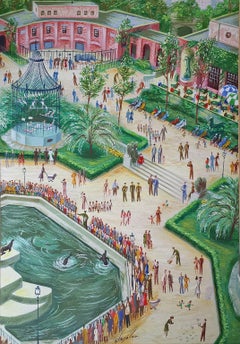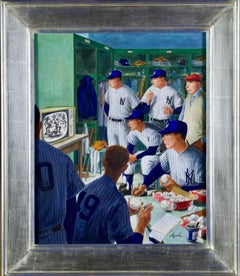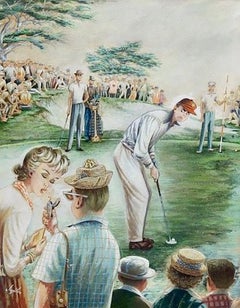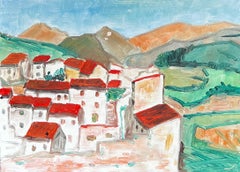Constantin Alajalov Paintings
to
6
2
4
2
2
4
Overall Height
to
Overall Width
to
2
5
2
2
2
2
2
2
2
2
1
1
1
6
2
1
2
6
919
650
639
610
6
6
6
3
Artist: Constantin Alajalov
Central Park Zoo with Sea Lions and Animals
By Constantin Alajalov
Located in Miami, FL
A charming and stylized depiction of a day at the Central Park Zoo. with World War Two uniformed visitors front and center. Sea lions put on a show in front of a packed audience. The...
Category
1940s Impressionist Constantin Alajalov Paintings
Materials
Gouache
New York Yankees Watching the Football Game
By Constantin Alajalov
Located in Fort Washington, PA
Signed Lower Right by Artist
Category
Mid-20th Century Constantin Alajalov Paintings
Materials
Gouache
Shooting Gallery, Saturday Evening Post Cover
By Constantin Alajalov
Located in Fort Washington, PA
Medium: Gouache on Board
Signature: Signed Lower Left
The Saturday Evening Post cover, September 12, 1953
Category
1950s Constantin Alajalov Paintings
Materials
Gouache, Board
Distracted Golfer, Saturday Evening Post Cover
By Constantin Alajalov
Located in Fort Washington, PA
Original cover illustration for The Saturday Evening Post, July 2,1960.
The Post described, ““Golfe '' was outlawed during its infancy in Scotland because too many archers, on whom ...
Category
1960s Constantin Alajalov Paintings
Materials
Gouache, Board
Zoo New York City with Sea Lions
By Constantin Alajalov
Located in Miami, FL
A charming and stylized depiction of a day at the Central Park Zoo. with World War Two uniformed visitors front and center. Sea lions put on a show in front o...
Category
1940s Impressionist Constantin Alajalov Paintings
Materials
Gouache
Telephone Exchange
By Constantin Alajalov
Located in Fort Washington, PA
Telephone Exchange, Cover of The Saturday Evening Post Magazine, April 7, 1962
Constantin Alajalov was the court artist to the Czar of Russia at the time of the Russian Revolution, barely escaping with his life before coming to America and getting a job illustrating for New Yorker magazine. He quickly adapted to the American way of life, and his cartoon-like drawings made his admiring public laugh at themselves. His many covers for The Saturday Evening Post were amusing, unique and highly collectible.
“The Telephone Exchange,” painted for the cover of The Saturday Evening Post on April 7, 1962, shows two young ladies chatting while a surprised telephone operator listens intently to learn the local...
Category
1960s Constantin Alajalov Paintings
Materials
Gouache, Board
Related Items
The Abduction of the Sabine Women , a Renaissance drawing by Biagio Pupini
Located in PARIS, FR
This vigorous drawing has long been attributed to Polidoro da Caravaggio: The Abduction of the Sabine Women is one of the scenes that Polidoro depicted between 1525 and 1527 on the façade of the Milesi Palazzo in Rome. However, the proximity to another drawing inspired by this same façade, kept at the Ecole des Beaux-Arts, and to other drawings inspired by Polidoro kept at the Musée du Louvre, leads us to propose an attribution to Biagio Pupini, a Bolognese artist whose life remains barely known, despite the abundant number of drawings attributed to him.
1. Biagio Pupini, a Bolognese artist in the light of the Roman Renaissance
The early life of Biagio Pupini, an important figure of the first half of the Cinquecento in Bologna - Vasari mentions him several times - is still poorly known. Neither his date of birth (probably around 1490-1495) nor his training are known. He is said to have been a pupil of Francesco Francia (1450 - 1517) and his name appears for the first time in 1511 in a contract with the painter Bagnacavallo (c. 1484 - 1542) for the frescoes of a church in Faenza. He then collaborated with Girolamo da Carpi, at San Michele in Bosco and at the villa of Belriguardo.
He must have gone to Rome for the first time with Bagnacavallo between 1511 and 1519. There he discovered the art of Raphael, with whom he might have worked, and that of Polidoro da Caravaggio. This first visit, and those that followed, were the occasion for an intense study of ancient and modern art, as illustrated by his abundant graphic production.
Polidoro da Caravaggio had a particular influence on the technique adopted by Pupini. Executed on coloured paper, his drawings generally combine pen, brown ink and wash with abundant highlights of white gouache, as in the drawing presented here.
2. The Abduction of the Sabine Women
Our drawing is an adaptation of a fresco painted between 1525 and 1527 by Polidoro da Caravaggio on the façade of the Milesi Palace in Rome. These painted façades were very famous from the moment they were painted and inspired many artists during their stay in Rome. These frescoes are now very deteriorated and difficult to see, as the palace is in a rather narrow street.
The episode of the abduction of the Sabine women (which appears in the centre of the photo above) is a historical theme that goes back to the origins of Rome and is recounted both by Titus Livius (Ab Urbe condita I,13), by Ovid (Fasti III, 199-228) and by Plutarch (II, Romulus 14-19). After killing his twin brother Romus, Romulus populates the city of Rome by opening it up to refugees and brigands and finds himself with an excess of men. Because of their reputation, none of the inhabitants of the neighbouring cities want to give them their daughters in marriage. The Romans then decide to invite their Sabine neighbours to a great feast during which they slaughter the Sabines and kidnap their daughters.
The engraving made by Giovanni Battista Gallestruzzi (1618 - 1677) around 1656-1658 gives us a good understanding of the Polidoro fresco, allowing us to see how Biagio Pupini reworked the scene to extract this dynamic group.
With a remarkable economy of means, Biagio Pupini takes over the left-hand side of the fresco and depicts in a very dense space two main groups, each consisting of a Roman and a Sabine, completed by a group of three soldiers in the background (which seems to differ quite significantly from Polidoro's composition).
The balance of the drawing is based on a very strongly structured composition. The drawing is organised around a median vertical axis, which runs along both the elbow of the kidnapped Sabine on the left and the foot of her captor, and the two main diagonals, reinforced by four secondary diagonals. This diamond-shaped structure creates an extremely dynamic space, in which centripetal movements (the legs of the Sabine on the right, the arm of the soldier on the back at the top right) and centrifugal movements (the arm of the kidnapper on the left and the legs of the Sabine he is carrying away, the arm of the Sabine on the right) oppose each other, giving the drawing the appearance of a whirlpool around a central point of support situated slightly to the left of the navel of the kidnapper on the right.
3. Polidoro da Caravaggio, and the decorations of Roman palaces
Polidoro da Caravaggio was a paradoxical artist who entered Raphael's (1483 - 1520) workshop at a very young age, when he oversaw the Lodges in the Vatican. Most of his Roman work, which was the peak of his career, has disappeared, as he specialised in facade painting, and yet these paintings, which are eminently visible in urban spaces, have influenced generations of artists who copied them abundantly during their visits to Rome.
Polidoro Caldara was born in Caravaggio around 1495-1500 (the birthplace of Michelangelo Merisi, known as Caravaggio, who was born there in 1571), some forty kilometres east of Milan. According to Vasari, he arrived as a mason on the Vatican's construction site and joined Raphael's workshop around 1517 (at the age of eighteen according to Vasari). This integration would have allowed Polidoro to work not only on the frescoes of the Lodges, but also on some of the frescoes of the Chambers, as well as on the flat of Cardinal Bibiena in the Vatican.
After Raphael's death in 1520, Polidoro worked first with Perin del Vaga before joining forces with Maturino of Florence (1490 - 1528), whom he had also known in Raphael's workshop. Together they specialised in the painting of palace façades. They were to produce some forty façades decorated with grisaille paintings imitating antique bas-reliefs.
The Sack of Rome in 1527, during which his friend Maturino was killed, led Polidoro to flee first to Naples (where he had already stayed in 1523), then to Messina. It was while he was preparing his return to the peninsula that he was murdered by one of his assistants, Tonno Calabrese, in 1543.
In his Vite, Vasari celebrated Polidoro as the greatest façade decorator of his time, noting that "there is no flat, palace, garden or villa in Rome that does not contain a work by Polidoro". Polidoro's facade decorations, most of which have disappeared as they were displayed in the open air, constitute the most important lost chapter of Roman art of the Cinquecento. The few surviving drawings of the painter can, however, give an idea of the original appearance of his murals and show that he was an artist of remarkable and highly original genius.
4. The façade of the Milesi Palace
Giovanni Antonio Milesi, who commissioned this palace, located not far from the Tiber, north of Piazza Navona, was a native of the Bergamo area, like Polidoro, with whom he maintained close friendly ties. Executed in the last years before the Sack of Rome, around 1526-1527, the decoration of Palazzo Milesi is considered Polidoro's greatest decorative success.
An engraving by Ernesto Maccari made at the end of the nineteenth century allows us to understand the general balance of this façade, which was still well preserved at the time. The frescoes were not entirely monochrome, but alternated elements in chiaroscuro simulating marble bas-reliefs and those in ochre simulating bronze and gold vases...
Category
16th Century Old Masters Constantin Alajalov Paintings
Materials
Ink, Gouache, Pen
1950's Modernist/ Cubist Painting - Red Roof Green Landscape
By Bernard Labbe
Located in Cirencester, Gloucestershire
French Landscape
by Bernard Labbe (French mid 20th century)
original gouache on board unframed
size: 9.5 x 13 inches
condition: very good and ready to be enjoyed
provenance: the art...
Category
Mid-20th Century Modern Constantin Alajalov Paintings
Materials
Gouache
Cy Twombly’s chair. Interiors Watercolor Painting
By Manuel Santelices
Located in Miami Beach, FL
Cy Twombly’s chair by Manuel Santelices
Ink, gouache, and watercolor on paper
Image size: 12" H x 9" W inches.
Unframed
2023
Manuel Santelices explores the world of fashion, soci...
Category
21st Century and Contemporary Contemporary Constantin Alajalov Paintings
Materials
Gouache, Watercolor, Ink, Paper
Freya (Seated Backwards), Mixed media on grey board
By Howard Tangye
Located in London, GB
Howard Tangye (b.1948, Australia) has been an influential force in fashion for decades. Lecturing at London’s Central Saint Martins for 35 years, including 16 years as head of BA Wom...
Category
2010s Contemporary Constantin Alajalov Paintings
Materials
Other Medium, Archival Paper, Handmade Paper, Pen, Felt Pen, Permanent M...
The Prince's Room
By Willy Pogany
Located in Buffalo, NY
Born in Szeged, Hungary, he became one of the better known and successful illustrators of the Golden Age of Illustration, completing over 100 books. Among them are "A Treasury of Verse for Little Children," "The Rubaiyat of Omar Khayyam," and "The Rime of the Ancient Mariner." He is probably best known for pen and ink drawings of mythology subjects geared towards children.
He studied at Budapest Technical University and attended art schools in Munich and Paris before moving to London at age 23. In 1907, he began illustrating children's books and did a series of annual gift books...
Category
1940s Realist Constantin Alajalov Paintings
Materials
Gouache, Graphite, Pen, Watercolor
British Mid 20th Century Impressionist Painting London City Sketch
Located in Cirencester, Gloucestershire
London
Frank Duffield (British, 1908-1982)
original watercolor painting on thick artist paper, unframed
size: 8 x 10.5 inches
condition: overall very good, minor wear to the edges as...
Category
Mid-20th Century Impressionist Constantin Alajalov Paintings
Materials
Paper, Watercolor
Summer Fashion. Young Victorian Lady With Meadow Flowers In Her Straw Hat
Located in Sutton Poyntz, Dorset
Alice Anne Renshaw.
English ( b.1849 - d.1900 ).
Young Lady With Meadow Flowers In Her Straw Hat
Watercolor & Gouache on Artist's Board ( An embossed stamp in the top left hand corn...
Category
Late 19th Century Realist Constantin Alajalov Paintings
Materials
Watercolor, Gouache, Board
H 29.93 in W 25.6 in D 2.96 in
Church Interior
By Ray Quigley
Located in Buffalo, NY
A modern illustration by American artist Ray Quigley depicting two men inside of a church.
Category
1950s Realist Constantin Alajalov Paintings
Materials
Gouache, Illustration Board, Ink
"Les Rois de Legendes #24 Musicien" The Kings Of Legend #24 Musician
Located in Berlin, MD
Erte (Romain de Tirtoff) Russian/French 1892-1990. "Les Rois de Legendes #24 Musicien" The Kings Of Legend #24 Musician. A beautiful, original gouache and ink piece (this is not a ...
Category
Early 20th Century Art Deco Constantin Alajalov Paintings
Materials
Ink, Gouache
Abstract Painting Green Dots, Gold Leaf and Blue Royal Society of Arts Africa
By Anthony Benjamin
Located in Norfolk, GB
Anthony Benjamin, 'Green Dots', acrylic and gouache on gold leaf board, image size 9" x 12", signed and dated 1999. Artist Estate Stamp on verso
Provenance: From the Artist Estate
A...
Category
1990s Abstract Constantin Alajalov Paintings
Materials
Gold Leaf
A Room by the Belgian visual artist and antque dealer Axel Vervoort
By Manuel Santelices
Located in Miami Beach, FL
A Room by Axel Vervoort, by Manuel Santelices
Ink pen, gouache, and watercolor on paper
Image size: 6 in. H x 8 in. W
One of a Kind
Unframed
2021
The w...
Category
21st Century and Contemporary Contemporary Constantin Alajalov Paintings
Materials
Ink, Paper, Watercolor, Gouache, Pen
Figures by River Landscape British Mid 20th Century Impressionist Painting
Located in Cirencester, Gloucestershire
Figures by River
Frank Duffield (British, 1908-1982)
signed original watercolor painting on thick artist paper, unframed
size: 10 x...
Category
Mid-20th Century Impressionist Constantin Alajalov Paintings
Materials
Paper, Watercolor
Constantin Alajalov paintings for sale on 1stDibs.
Find a wide variety of authentic Constantin Alajalov paintings available for sale on 1stDibs. You can also browse by medium to find art by Constantin Alajalov in gouache, paint, watercolor and more. Much of the original work by this artist or collective was created during the 20th century and is mostly associated with the Impressionist style. Not every interior allows for large Constantin Alajalov paintings, so small editions measuring 10 inches across are available. Customers who are interested in this artist might also find the work of Francis Luis Mora, Wilson Henry Irvine, and Everett Shinn. Constantin Alajalov paintings prices can differ depending upon medium, time period and other attributes. On 1stDibs, the price for these items starts at $24,000 and tops out at $95,000, while the average work can sell for $75,000.







